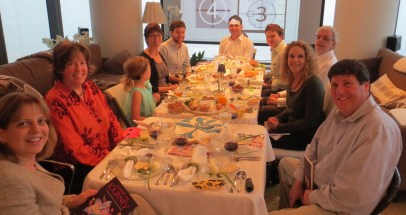I first heard of Emmanuel Levinas when I was a first year student in rabbinical school. Rabbi Levi Lauer, then head of Diapora-Israel relations and scholar at Shalom Hartman Institute, addressed first-year students in hopes of recruiting some of us to attend Hartman’s seminar for rabbinical students. In the midst of his remarks, he summed up the essence of the philosophy of Levinas in one sentence. I still remember Lauer’s phrasing: “When you meet another person and look into their eyes, you take responsibility for them.” This notion of the mutual responsibility of humanity resonated deeply.
I barely studied Levinas in rabbinical school– just one hour in a class with Dr. Eugene Borowitz. It wasn’t until I came to Chicago, three years out of school, that I began to study him.
When I arrived to Chicago, I almost immediately found a perfect chevrutah, the extraordinary Rabba Rachel Kohl Finegold. We decided to learn together Nine Talmudic Readings by Emanuel Levinas. She was the Gemara queen and I had “a bit” of a knack for the commentary by Levinas. We managed to get through four of his transcribed lectures before life intervened in our intensive studies.
One lecture stood out among the rest– “Temptation of Temptation”. There, he analyzed the passage from the Talmud (BT Shabbat 88a-b) beginning with the midrash of God holding Mt Sinai over the Hebrews like a titled tub. In his analysis, Levinas criticizes “Western Man” for his constant dabbling into ideas, never committing to any one thing. Yet, in our receiving of Torah, the Israelites accepted the ethic of action– of responding to the Other. At our core, according to the ideal of Levinas, we understand that “the messenger is the message.”
I have studied this lecture intensively three times now. First with Rachel, then with a beloved colleague and conservative rabbi Adam Kligfeld. And this year, I studied it with high school senior Caroline Kaplan. I want to share with you excerpts of how she described the experience in her Dvar Torah at her Kabbalat Torah ceremony:
For months now I’ve had a sticky note up in the corner of my computer. It reads, “We live in a world that gives no room to be what we dreamt of being”. Poet Adrienne rich wrote this. She was a woman, a Jew and gay, none of which are easy to be. …
I connected with this quote because she articulated the hopelessness I’d seen around me.
How can we move forward when there is so much to do, so much to repair, and so many distractions that keep us from truly committing to do good works?
The answer is at once both obvious and complicated; so of course Torah and the great scholars who study it could only give the answer. I was looking for a place, something to ground me, to give me purpose. I needed to reconnect. That’s what I told Rabbi Conover, and she immediately knew what I needed. “Levinas!” she said, and she couldn’t have been more right.
Together we read Levinas’s Talmudic commentary entitled “Temptation of Temptation”, which made me understand what it means to truly live Jewishly.
The passage in the Talmud begins with a famous Midrash.
“God inclined the mountain over [the Israelites] like a tilted tub and said: If you accept the Torah, all is well, if not here will be your grave.”
Levinas saw this not as being threatened with physical death, but instead the threat was an even greater one. If we didn’t accept Torah we were to spend the rest of our lives just wandering in the desert—tempted by all kinds of ideas and interests. The wandering and never committing to a real ethic would’ve been the greatest death of all.
The passage in the Talmud continues on with the response of the Israelites when we are offered the Torah. We responded: Naseh vinishma, “we will do, and we will hear “ implying we will do before we hear.
So what does it mean to do before hearing?
According to Levinas it means to truly respond to another’s need, without weighing all the available opportunities, or contemplating all the other options. … According to Levinas,“Consciousness is the urgency of a destination leading to the other person and not an eternal return to self.” So much of my learning in secular education and in my life has been about dabbling. Learning for knowledge’s sake, being well rounded. … Torah teaches us that there is only one true piece ofknowledge that we must learn: “The messenger is the message.” Our duty is to respond to their needs, their voice. It’s a different kind of learning and being in this world. And that’s what I’m embracing when I receive Torah this evening. That’s the way I want to live in this world, by acting. Not just so I can become what I dreamt of being, but so I can listen and respond to others—help their dreams to be realized too.
In my life I’ll extend my hand whenever needed. I’ll wander through this desert with a purpose. This connecting with others is what I need to do, hearing the needs of the ones aroundme and responding. This is how the people like …family have begun to change the world. In the years to come I’ll join them in making room for dreams to be realized, those who commit and act, those are the ones who repair the world, and that is the type of woman I’m becoming.
My family at home has certainly helped me strive to become this kind of woman, yet my family here at the Temple has inspired and embraced my development as a Jew and as a person in crucial ways.

Rabbi Shoshanah Conover serves Temple Sholom of Chicago.

















